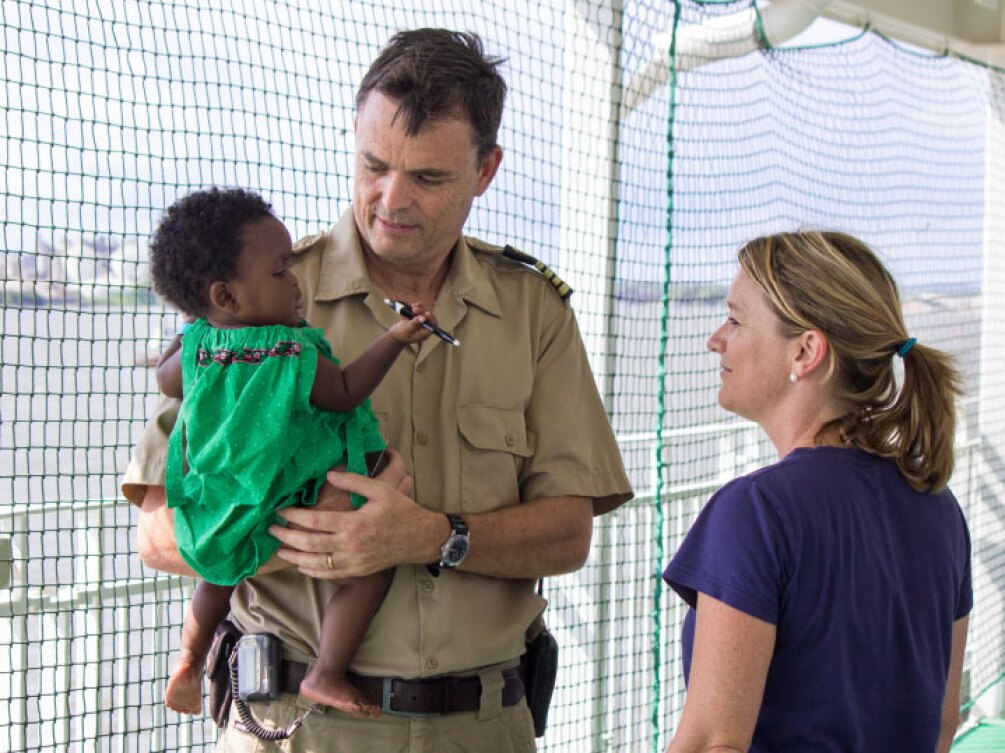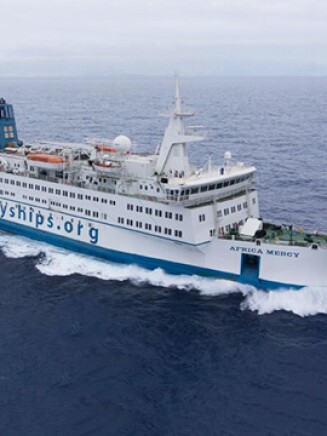Travel photos are often a collection of technicolor sunsets, stunning locales and festive dinners out. But some of the pictures Lee-Anne James treasures most from her trips around the world are a little different.
A Senior Manager of Clinical Operations within Johnson & Johnson Innovative Medicine, Lee-Anne has spent much of the last two decades volunteering aboard Mercy Ships—a nonprofit organization that brings desperately needed surgical care and surgical education to under-resourced countries. Johnson & Johnson is a longtime partner of Mercy Ships, donating medical supplies and offering volunteers like Lee-Anne the opportunity to help deliver healthcare to those who need it most.
Wherever a Mercy Ship has taken her—from African nations to Honduras to the Dominican Republic—Lee-Anne has helped babies, children and adults prepare for complicated procedures like cleft lip and palate repair and the removal of head and neck tumors. She is often one of the first volunteers people talk to after they’ve traveled by bus or walked for days to board the ship while it’s docked at a coastal port. And she’s among the last to say goodbye after they have obtained care they may have waited years for.
As a mother, Lee-Anne feels a special bond to the mothers who come on board—and she has always made her volunteer missions a family affair. On each trip, her husband, John Borrow, who is also a volunteer, and their two teenage sons, Tim, 17, and Sam, 15, accompany her.
Though each mission can last several months or even years, Lee-Anne and her brood are comfortable with life on a floating hospital and wouldn’t have it any other way.
Lee-Anne has been asked by friends and relatives, “Are you sure this is a good idea for your family?” Each time, she has the same response: “‘It may not be for every family, but it is quite a good fit for us.” For National Cleft & Craniofacial Awareness & Prevention Month, she shares her family’s story.
Making Miracles at Sea
In many countries, it’s easy to take access to surgery for granted. But around the world, timely doctor visits and quality emergency care are the exception rather than the norm. As a result, many children and adults die from painful injuries and illnesses that should be treatable. In under-resourced countries, one-third of all deaths could be prevented with simple access to surgical care.
In 1978, Mercy Ships was founded as a way to bring healthcare providers to the people who need them most. Currently, the organization has two floating hospitals, the Africa Mercy and the Global Mercy. Both are equipped with state-of-the-art operating rooms, hospital wards, a lab, imaging center and even a blood bank. In 2023, an estimated 800 surgeries are expected to be performed on the Global Mercy alone.
Every year, 1,200 volunteers like Lee-Anne and her family come from all over the world to run Mercy Ships’ day-to-day operations. That includes doctors, nurses, technicians and other healthcare professionals, as well as carpenters, plumbers, electricians, teachers, bakers, receptionists, accountants and videographers.
For nearly 30 years, Johnson & Johnson Foundation has been providing operational support to Mercy Ships in addition to product donations from Johnson & Johnson operating companies.
“Changing the trajectory of health for all is one of Johnson & Johnson’s focus areas, and in particular, supporting those on the frontlines of healthcare,” says Kim Keller, Senior Manager of Global Community Impact for Johnson & Johnson. “Mercy Ships meets both of those goals very clearly.”
Another core mission of Mercy Ships is to help build up health infrastructure in underserved regions of the world. Aside from providing medical care, the organization regularly donates equipment and offers ongoing mentoring and training to local medical professionals. In 2023, Mercy Ships plans to train more than 600 healthcare providers in specialties like mental health, primary trauma care and neonatal resuscitation.
“Mercy Ships provides a sustainable connection with [each country’s] formal healthcare system, which really does build economy and community,” explains Keller.
A New Way of Life Begins
Lee-Anne and John first heard about Mercy Ships in the 1990s, back when they were in their twenties and dating. The nonprofit’s mission resonated with their faith and desire to give back to others.
After marrying in 2001, they submitted applications, underwent interviews and physicals and began their first volunteer commitment together on a now-retired ship called the Caribbean Mercy. John, who is a sea captain, served as a ship’s officer. Lee-Anne helped schedule surgeries. “It was a way to combine John’s maritime experience and my medical work,” says Lee-Anne, who is also trained as a dietitian.
That first mission was the start of a new way of life, which continued as the family expanded. (Their older son, Tim, went on his first mission when he was 4 months old.) So far, the Borrow family has volunteered with Mercy Ships four different times, one time living on one of the ships for three years.
As Lee-Anne’s dedication to Mercy Ships solidified, it became important to her to be part of a company that better appreciated her devotion to volunteering. When a position opened up at Johnson & Johnson four years ago, she applied. She got the job, which she’s held ever since.
“The company encourages volunteering, and the company helps me to maintain my passion working with Mercy Ships,” says Lee-Anne, who works remotely on the ship when she’s aboard as a volunteer. She took advantage of Johnson & Johnson’s volunteer leave policy for her latest deployment, which gave her three paid days off.
The Emotional Toll of Prepping Babies for Surgery
At home in Australia, Lee-Anne oversees the feasibility for Johnson & Johnson clinical trials in Australia and New Zealand. On board a Mercy Ship, she’s been tasked with a range of responsibilities over the years. Besides helping to schedule surgeries, she’s helped treat obstetric fistulas (a tear in the birth canal that can develop after prolonged, obstructed labor) and provided speech therapy to children and adults who’ve recently had maxillofacial or cleft palate surgery.
She’s also managed the infant feeding program, which helps underweight babies prepare for surgery to fix cleft lips and cleft palates. It’s an important role, but one that can be emotionally tough to process. Both these birth defects prevent the lip or mouth from developing properly. If not surgically corrected early on, a baby’s ability to breastfeed or nurse from a bottle could be severely hampered.
Many babies show up at the ship too underweight to safely undergo corrective surgery. Working with a translator, Lee-Anne helps each mother understand how she can make it easier for her baby to put on weight. Lee-Anne gives the mothers formula and a special feeding bottle that doesn’t require the baby to suck or a high-calorie fortified peanut butter mix that helps babies quickly gain weight.
Lee-Anne remembers one baby who was so underweight that she worried he would die in her hands. After being immediately admitted to the ship’s hospital and starting on a feeding tube, he significantly improved over the next week. But the experience unsettled her: It seemed unfathomable that the life of an otherwise healthy child was in danger because of an issue so easily fixable.
For every baby Lee-Anne helps, she knows there are more who won’t be ready for surgery or whose families haven’t been able to bring them to the dock before the mission ends and the ship leaves.
“I learned very early on that the people in front of me were the ones that I needed to help,” she notes. “I really try to focus on giving them my entire attention.”
Life Aboard a Floating Hospital
Living on a Mercy Ship is like residing in a small city. Each ship, nearly the length of two football fields, is set up with a bank, laundry facility, convenience store, post office, hair salon and gym, as well as a lending library of movies and board games.
Amenities like these make life easier for volunteers, especially the handful of volunteer families with children, like the Borrow family. “It’s a pretty amazing place to connect,” Lee-Anne says. “You meet people and soon feel like you’ve known them forever.”
On each trip, the family hunkers down in a two-bedroom cabin that includes a living area, bathroom and small kitchen with a microwave and refrigerator. If they want to cook, they use the crew’s galley.
Although meals are also provided to volunteers in the ship’s dining room, the couple and their boys carve out family time by eating together in their cabin. After breakfast on a typical mission, the kids head to the accredited K-12 school on board while Lee-Anne works with patients on the dock. John stays on deck, helping to make sure everything on the ship is running smoothly. After lunch, the kids play computer games, basketball or soccer until dinner. Tim and Sam’s friends include the children of other ship volunteers as well as kids who were recovering in the ship’s hospital ward.
When the boys were younger, “I did have a little bit of guilt—pulling the kids out of school and taking them to Africa,” says Lee-Anne. “But it felt like the right thing for our family, and they thrived.”
“They’ve built amazing relationships that they’ll keep for the rest of their lives,” she adds.
Living in the ports of some of the world’s most underserved countries has provided plenty of teachable moments. “We had to talk through a lot of things other kids probably haven’t,” says Lee-Anne. “We talked through how each country does things differently and may not distribute wealth evenly. We had lots of discussions about politics.”
And while these conversations aren’t easy, the experiences living on Mercy Ships have given Tim and Sam “a really good worldview,” she says. “They have the perspective now of looking through other people’s eyes.”
Feeling Gratitude for the Chance to Give Back
Harder than leaving home to live on a Mercy Ship for months or years at a time is coming back to Australia and living a “normal” life on land. “It’s like reverse culture shock,” says Lee-Anne.
Even so, she always returns home with a renewed sense of gratitude for the medical care so easily available to her family.
Her gratitude has been even stronger lately, ever since John told her what he overheard some of the deck workers say early in the morning before starting their day’s work: “Thank you God, for the breath I still have this morning.”
“Before that, I’d never woken up and been thankful just that I was still breathing,” Lee-Anne says. “Being thankful for the small things—I feel that’s a good way to live.”
Right now, John is still on the Global Mercy in Senegal. Lee-Anne and the boys recently returned to Sydney so Tim can graduate from their local high school. She’s optimistic that they’ll find time to volunteer as a family again sometime in the future.
“Mercy Ships will always be part of our world,” she says. “It’s part of who we are now.”










